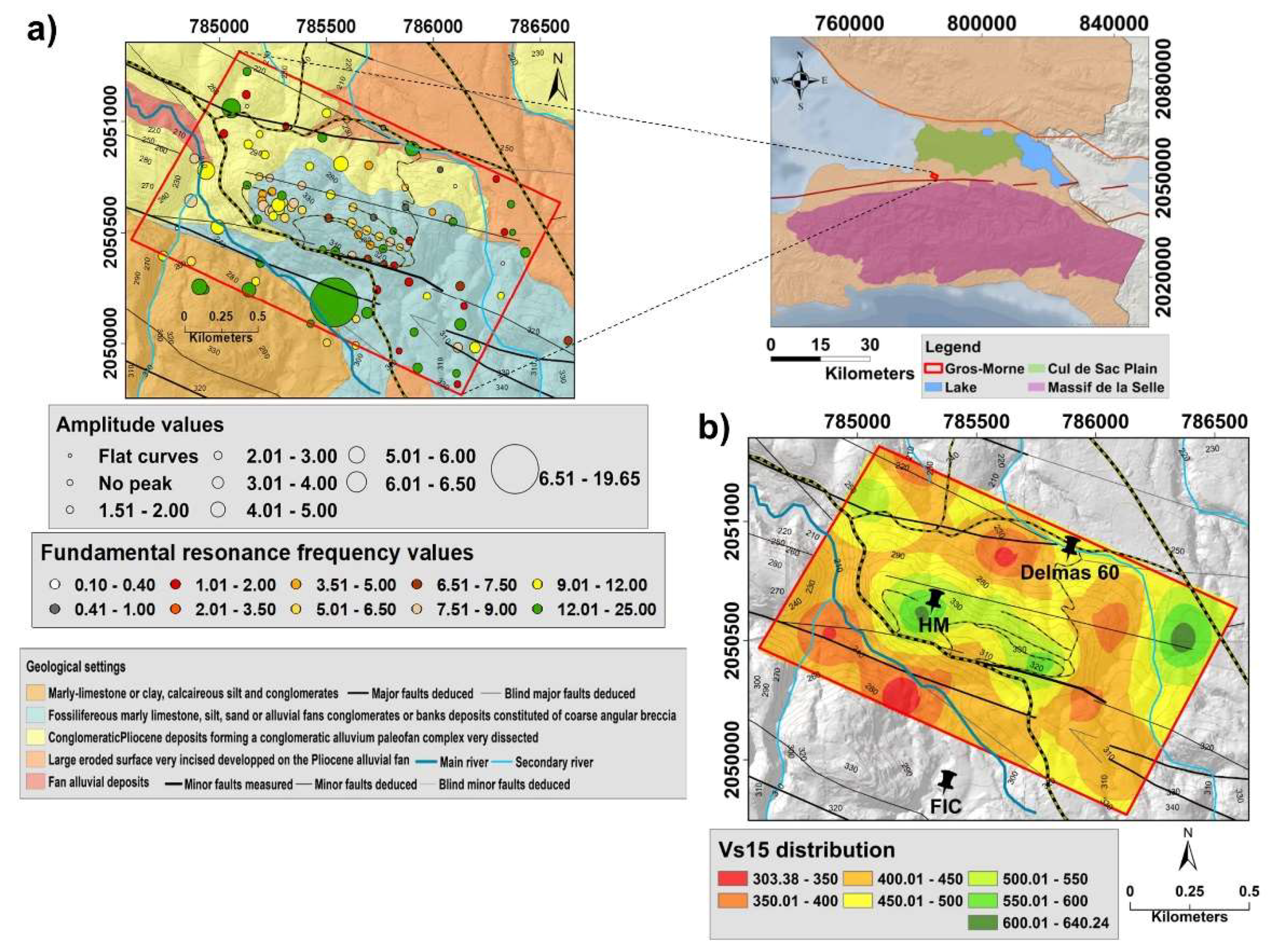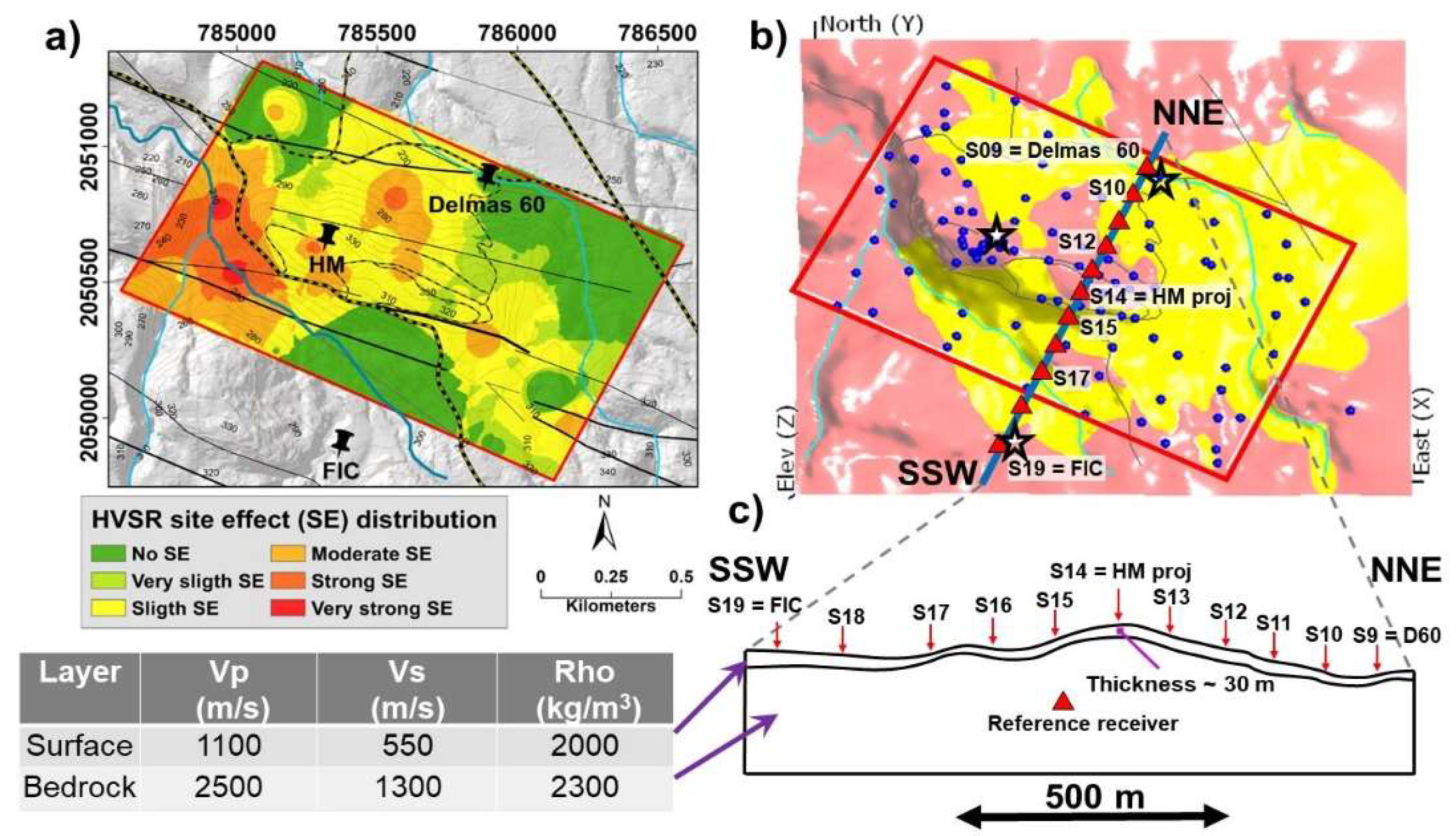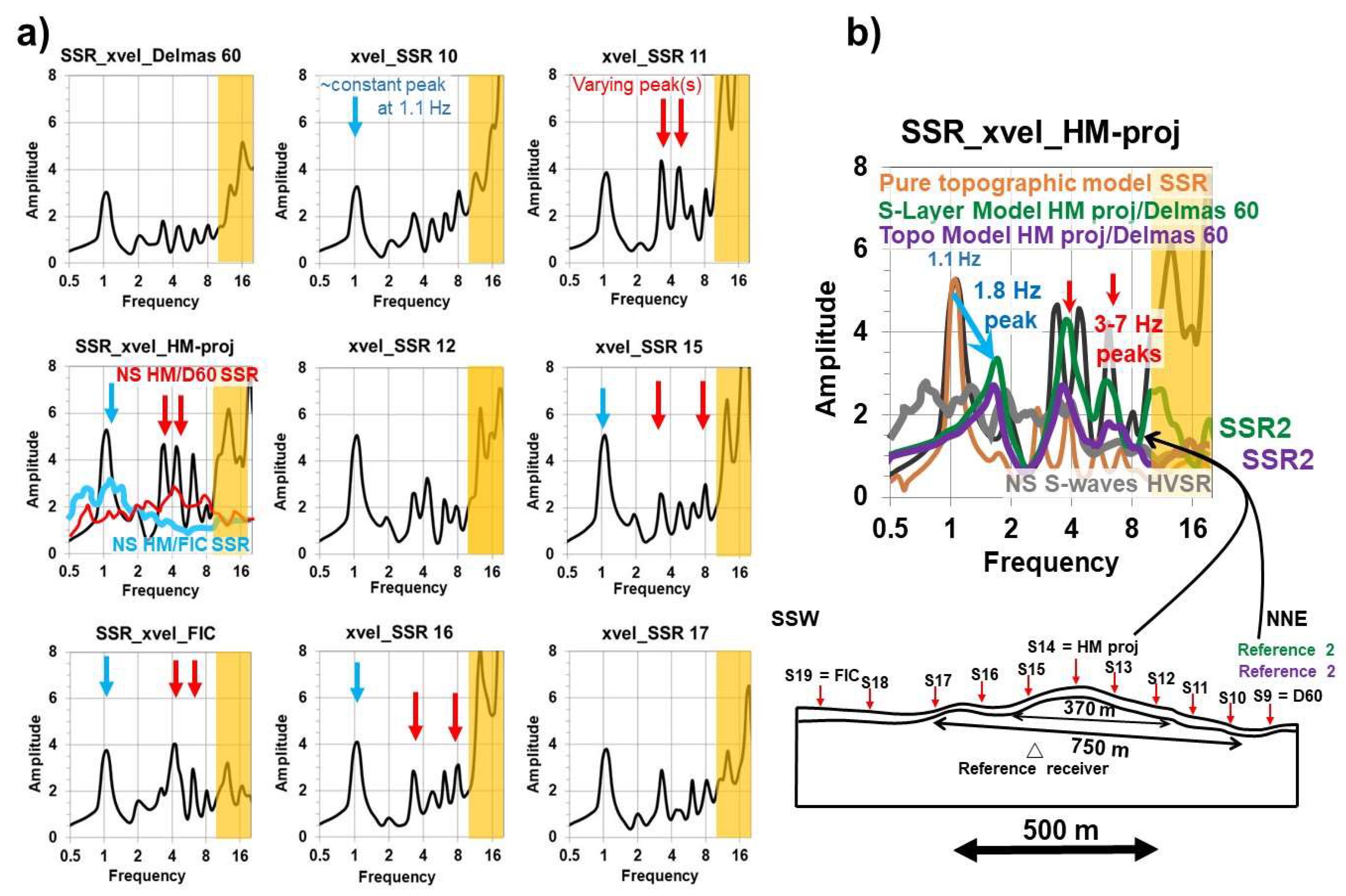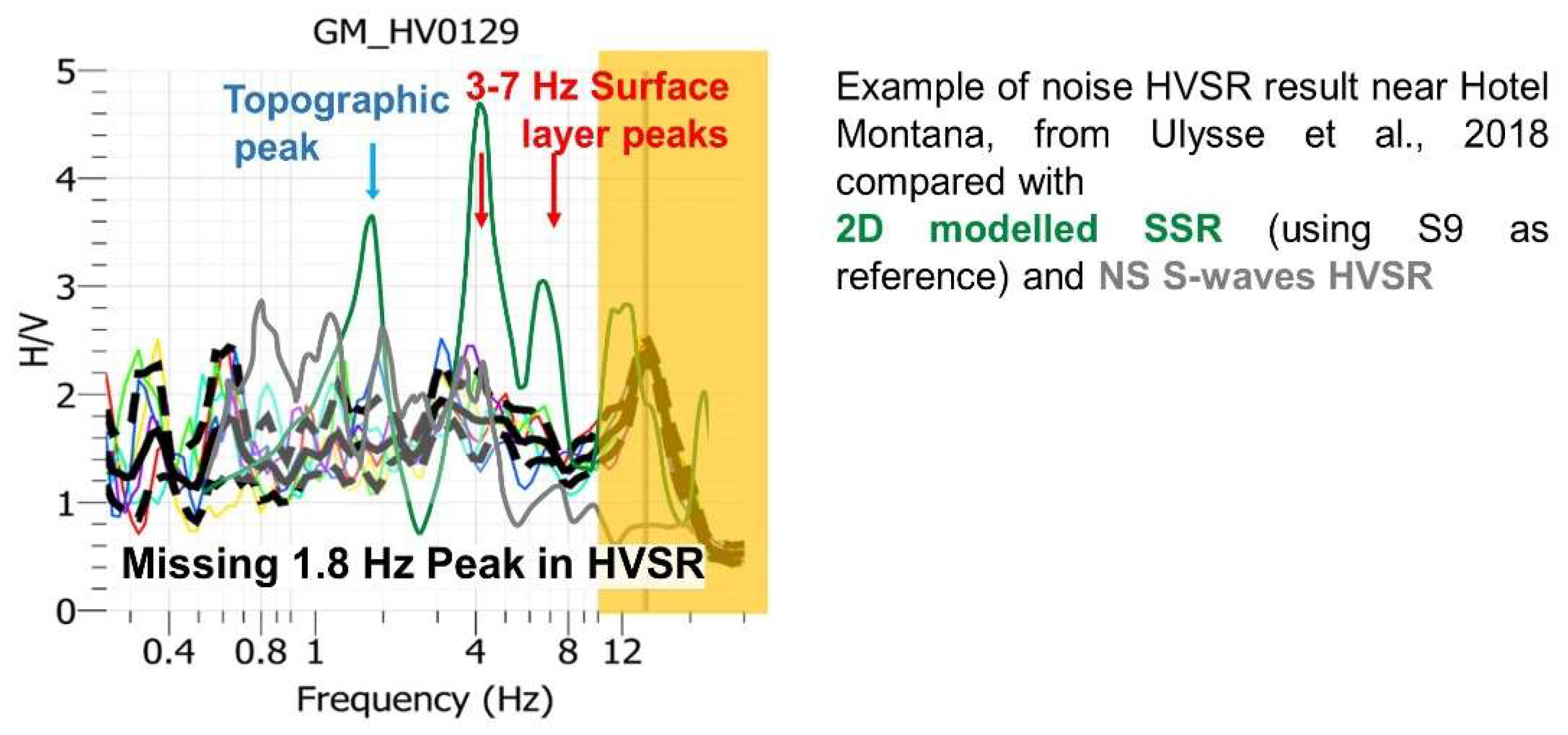3.1. Site Effect Distribution Maps
Site effect characteristic maps of the study area are presented in
Figure 3. As a preliminary approach to seismic microzonation of the target area, we first interpolated the values, respectively, of the HVSR fundamental resonance frequencies (of the clearest low-frequency peak) and of the related peak amplitudes (related maps are presented in
Figure 3a,b below). An overview map of the ground motion polarization at the identified resonance peaks is shown in
Figure 3c; the preferential shaking orientation is represented by a red double-arrow (with size proportional to the peak amplitude averaged for both horizontal components). It can be seen that those polarizations are quite variable over the hill; only those in the north and south of the central part of the hill are roughly parallel to the short axis of the morphological structure (marked by the large brown double arrow in the map in
Figure 3c below). To get a clearer overview on this phenomenon, we also plotted black double-arrows on that map to represent the polarization of resonance motion for a group of measurements. If we compare the black double-arrows with the local slope gradient direction (marked by violet arrows in the same map), we can see that they are preferentially parallel to them. Thus, it can be concluded that the polarization of the ground motion at the identified resonance frequencies is rather influenced by the local slope orientation than by the one of the hill as a whole (especially near the western and eastern end of the hill). Actually, all identified HVSR peaks along the top parts of Gros-Morne hill occur at frequencies clearly higher (>3 Hz) than the likely hill resonance frequency that would be between 0.5 and 2 Hz (inferred from the SSR presented above). Those peaks are, therefore, most likely caused by soft layer ground motion resonance rather than by the hill shaking resonance. Nevertheless, with an azimuth generally parallel to the slope gradient, these peaks seem to be marked by a slight and more local morphological effect as well.
The two first maps (of interpolated resonance frequencies and peak amplitudes) have been combined to provide a map of site effect intensity (included in
Figure 4). Areas with stronger site effects are considered to be characterized, first, by higher HVSR peak amplitudes (>3) and, second, by fundamental resonance frequencies relevant for earthquake engineering purposes (below 9 Hz). Zones marked by a combination of those characteristics are filled by orange to red colors in the HVSR site effect distribution map in
Figure 4a; such zones can be found in two main areas around the Gros-Morne hill, a larger zone in the west, and a smaller one in the north of the hill. The Hotel Montana is located in an intermediate zone characterized by moderate estimated site effects with HVSR amplitudes that can reach values of 3, at frequencies between 5 and 12 Hz. It should be noted that the combined information does not consider topographic effects (at lower frequencies), but only site effects potentially resulting from soil amplification.
In
Figure 4, the “HVSR site effect” map (
Figure 4a) is compared with the Vs
15 map (
Figure 4b) that has already been introduced above. It can be observed that areas marked by larger “HVSR site effects” present highly variable Vs
15 values. Along the ridge where relatively large Vs
15 values have been measured, both low and moderate to locally strong “HVSR site effects” can be found. In the southwest, zones are characterized by both low Vs
15 values and medium-strong site effects. The northeastern corner, near the road
Route de Delmas, seems to be the least prone to soil amplification with high velocities similar to those measured at Hotel Montana, but marked by weak “HVSR site effects”. Comparing the maps of the Vs
15 values and “HVSR site effects” with an extract of the 2010 damage distribution map (
Figure 4c) produced by [
13], two main zones can be identified: the first zone in the west and south presents a moderate to good agreement between observed damage distribution and estimated site effects (with green outline in
Figure 4c), while the second zone in the northeast presents a weak agreement between observed damage distribution and estimated site effects. The first zone includes two types of areas: for two areas in the northwest and south, lower site effects have been estimated, and scarcer damage had been observed while we assessed larger site effects for the central area, where, indeed, more extensive building destruction was evident. According to our estimates of site effects, the northeastern zone (district of Delmas) should not be exposed to strong ground motion amplification; nevertheless, it was affected by widespread damage.
3.2. Geophysical–Seismological Results Used to Build a 3D Geomodel
The thickness of the amplifying surface layers covering the hill was assessed and mapped on the basis of the joined HVSR and MASW results. Therefore, we used the resonance frequency peaks of the HVSR noise curves to compute the thickness of the different layers by applying the 1D assumption relation f0 = Vs/4h. The Vs parameter considered here is the average shear wave velocity obtained from the MASW measurements for the first 15 m (Vs15-value introduced above). Given that the relation f0 = Vs/4h is only applicable in the case of a soft layer overlying hard rock (or any denser layer), it was exclusively used for recordings showing a clear (sharp) resonance peak (amplitude ≥ 2). For locations marked by flat-shaped HVSR curves, it can be assumed that no very soft layer is present near the surface. At those sites, only the seismic data were used to estimate the subsurface structure. The validity of this approach is analyzed in the Discussion section below.
The low-velocity layer thickness values estimated by the above method were combined with the surface data to build a 3D geomodel of the Gros-Morne hill by using the Leapfrog Geosoftware (developed by ARANZ GEO, Christchurch, New Zealand). The resulting 3D geomodel presented in
Figure 5 can be considered as a preliminary result as only geophysical data have been used to construct the subsurface; at the time of model construction, no borehole data were available (see also Discussion below).
The geomodel basically consists of two layers: the bedrock (green volume, see
Figure 5) and the soft rock (yellow layer) that produces the fundamental resonance frequency peak. However, as a second frequency peak (and sometimes even a third one which is not considered here) was also observed for many investigated sites, the soft layer was regionally split into a shallow low-velocity (discontinuous shallow brown layer) and an intermediate layer (continuous yellow layer on top of the entire bedrock volume); the brown low-velocity layer is only present in zones marked by the occurrence of a second clear resonance peak, except for the northwestern corner, where it defines a single thick layer. Actually, the continuous yellow layer basis crosses the brown layer basis near the northwestern corner, due to extrapolation problems in this part of the model (see zone marked by the red ellipse in
Figure 5b); yet, this does not modify the total thickness of the soft layer and the zone is located mostly outside the investigation area. The thickness of these near-surface layers (both the brown and the yellow layers) was computed by applying the aforementioned relationship h = Vs
15/4f, with f representing the identified resonance frequency. The computed thicknesses of the shallow sedimentary layers vary between 5 and 27 m. Therefore, we considered that the maximum study depth is 30 m, and consequently placed the lower limit of the logs H/V at this depth (this depth has no effect on the model itself, that was purely built by interpolating surface topography and layer contact points). In this regard, a first source of error can be highlighted, the one of the probable underestimated thickness for sites where the computed layer thickness is clearly larger than 15 m, as the equivalent average shear wave velocity is likely to be larger than the Vs
15-value that was used for thickness calculation. The logs, representing the thickness of the combined second and (where present) of the third layer, are represented by log-bars in
Figure 5b.
From 106 HVSR recordings and 16 MASW measurements, a first model was computed, as explained above. In order to get the shear wave velocity values at each HVSR recording point, we used the nearest value indicated by the Vs
15 distribution map shown in
Figure 4b. However, as observed in
Figure 5a, the first model also produced some interpolation errors due to data sparsity, notably for areas where we could not make any recordings during the field survey (partly due to inaccessibility of sites located on steep slopes of the hill). In order to have a better distribution of the frequency values to model the amplifying layers, two HVSR depth logs were added to areas with missing measurements; those added depth logs take into account the frequency and the velocity values, and consequently, the thickness values calculated for the surrounding HVSR sites; they were needed as, due to the changing topography in the sparse data areas, the interpolated surfaces crossed each other (and crossed also the topographic surface, similar to the extrapolation problem highlighted above, for crossing the yellow basis surface by the brown layer basis in the northwestern corner; note, an additional extrapolation problem appears in the western part of the model where the brown surface layer becomes very thick—but this appears mainly outside our target area). In the
Figure 5c below, we show the final model with the measured HVSR logs (blue points) and the added ones (red points). The white points are the seismic stations plotted on the model. The other views (
Figure 5d,e) respectively show an E–W section, as well as a map-view of the model.
The map-view of the resulting geomodel presented above in
Figure 5e is also compared with the HVSR site effect distribution map in
Figure 6. This comparison shows that the shallow brown and yellow layers roughly correspond to, respectively, the orange to red, and the yellow to green areas of the HVSR site effects map. Thus, in the geomodel, the shallow yellow layer is related to areas marked by a weak to moderate potential of site amplification, while the brown layer outlines zones where moderate to strong site effects can be expected. Areas with the strongest soil amplification potential are distinguished from those with moderate site effects by their greater thickness. Indeed, from a north–south section view in
Figure 5d, it can be seen that these low velocity layers (<400 m/s) are thicker in the southwestern foothill and very thin on the hilltop. Likewise, moderate site effect areas can be outlined by means of the thickness of the yellow layer. In the northeastern corner, where weak site effects have been identified, the yellow layer is thinner, while it is thicker on the slope going to the ridge. It is important to note that among the three seismic stations, only the Delmas 60 one is located in an area where the brown layer is not present.
From the 3D geomodel, a 2D section with simplified geology was extracted (shown in
Figure 6c); it includes a surface layer marked by P-wave (Vp) and S-wave (Vs) velocities, and a volumic mass that were averaged over the entire layer, as well as a bedrock with estimated average elastic properties marked by Vs of 1300 m/s (see table in
Figure 6). The estimates of elastic properties for the bedrock are based on data published by [
14], which have also been discussed in [
3]. This 2D section presented in
Figure 6c was used for elastic dynamic simulations that are presented in the next
Section 3.3.
3.3. Simple 2D Numerical Models of the Target Site
In order to better understand the observed amplification effects on and near the Gros-Morne hill, dynamic numerical modelling was performed. The tool applied for those simulations is based on the distinct element method (DEM) which is a numerical solution used to describe the mechanical behavior of discontinuous bodies. The latter are systems composed of discrete elements or blocks (here, the layers marked by different elastic properties) separated by interfaces (here, the layer boundaries). Introduced by [
15], the DEM was developed for the analysis of rock mechanics and was later implemented in the 2D UDEC software (Universal Distinct Element Code, Itasca consulting group). The UDEC software actually combines the DEM with the finite difference method (FDM), determining the deformation of the material inside a block, which allows for a more general application of the tool. In particular, the latter component is essential for the simulations carried out for the Gros-Morne site as the compliance of the rock matrix is of relevance in the considered problem; therefore, each block (here, the surface layer and the bedrock) can be subdivided into zones to enable internal deformation computed by FDM. The main advantage of subdividing the medium into distinct elements is to allow the system to evolve further than a continuous FD or FE continuum, and to enable singular blocks to deform separately. However, in the present case, the singular block deformation option was not used, and the model was constructed as a continuum, and this by “gluing” the contact (by setting very high joint cohesion values) between the surface layer and the bedrock. It should be noted that we modelled only in the elastic domain; to simulate the effect of energy dissipation (such as through viscous attenuation), the implemented Rayleigh damping scheme was applied (see explanation, e.g., in [
16]); along the boundaries, free field conditions were included.
The 2D numerical calculations were applied to the NNE–SSW section extracted from the 3D geomodel of the hill (
Figure 6), which is perpendicular to its main axis of elongation, and extends from the FIC to the Delmas 60 sites. The section is 1230 m long, and reaches a maximal elevation of 333 m on top of the Gros-Morne hill. The section initially includes three main elements deduced from the 3D model: the two surface layers and the basement (bedrock). For the simulations, this structure has been simplified, and only one single surface layer with average elastic properties was included (simplification was applied as this is a preliminary study that will be more developed within a future project). Amplification effects can, therefore, only vary along the model surface, due to the changing layer thickness (depending on the local measured HVSR fundamental frequencies that were used to construct the 3D geomodel), and due to the local topography. For both the surface layer and the bedrock material, the bulk and the shear moduli (K and G), as well as the volumic mass had to be defined, the two first on the basis of the Vp- and Vs-values determined for those layers (see elastic properties in the table in
Figure 6). Also, the response of a pure topographic model has been simulated; in this model, the surface layer characteristics are the same as for the bedrock.
Along the surface of the model, eleven surface receivers have been inserted; additionally, one subsurface receiver was included in the middle of the model at a depth of about 120 m. The configuration of the model and receiver locations is shown above in
Figure 6c, as well as in
Figure 7. At the basis of the model, three successive Ricker wavelets marked by two central frequencies at 1.5 and 4 Hz (with main vibration in the x or the horizontal direction) have been introduced, and propagated upward across the model. The signal recorded at the reference receiver and the corresponding spectrum, as well as the doubled spectrum, supposed to represent the one of a surface receiver on bedrock, are shown in the lower part of
Figure 7 (there, see also the dashed signal with doubled amplitudes). An example of signal and corresponding frequency spectrum recorded on top of the Gros-Morne hill (at receiver S14 representing a site equivalent to the one of Hotel Montana) is shown in the upper part of
Figure 7. The standard spectral ratios (SSRs, see left part of
Figure 7) were computed for the eleven surface receivers by dividing the respective surface receiver spectrum by the doubled subsurface reference receiver spectrum. Parts of the input signal spectrum that do not include sufficient energy (and are not considered for analysis) are masked by an orange semi-transparent rectangle in all figures below.
SSRs are presented for nine surface receivers in
Figure 8 (with the high frequency part masked due to insufficient energy in the input signal). For the equivalent HM receiver S14 (middle left part of
Figure 8a), the modelled SSR is compared with the measured NS SSR obtained with respect to FIC station (in blue) and to Delmas 60 station (in red). The same modelled SSR is enlarged and compared in
Figure 8b, with the NS S-waves HVSR (in grey) and with the SSR obtained for the equivalent location in the purely topographic model (in beige, with surface layer characteristics identical to those of the bedrock, marked by Vs = 1300 m/s). This comparison shows that the first peak at 1 Hz is produced both by the purely topographic model and by the model including a softer surface layer (with Vs = 550 m/s). The results in
Figure 8a show that this first peak is present at all sites, but changes in amplitude, the smallest one (~2.8) was obtained for the low-altitude site in the NNE part of the section, and the highest one (~5.3) for the receiver near the hill top (representing the equivalent HM site). The SSR obtained for the hill top in the purely topographic models also presents smaller peaks at higher frequencies. It should be noted that at similar frequencies, the model with a soft surface layer produces clearly larger amplifications. The combined measured NS SSR computed with respect to FIC and Delmas 60 station shown in
Figure 8a and the NS S-waves HVSR, altogether, present several moderate peaks between 0.5 and 9 Hz; from the comparison with the modelled SSRs for the hilltop site (for both the purely topographic model and the one with a surface layer), it can be inferred that the low frequency peak around 1 Hz is likely to be due to topographic amplification, and those above 2 Hz are probably related to surface layer site effects.
However, the size of the ‘”topographic” peak (amplitude > 5) is surprising, as topographic amplification is generally limited to factors of 2–3. Actually, in the field, topographic amplification is almost exclusively assessed with respect to other surface receivers, especially those located at the foot of the hill or mountain structure. Here, the SSRs were computed with respect to a subsurface receiver that is located at a great depth well below the basis of the hill. Therefore, in
Figure 8b, we included also the SSR graphs for the equivalent HM site computed with respect to the smallest response that had been simulated for a surface receiver, i.e., for S9 that represents the Delmas 60 site (marked by a low altitude and by a thin surface layer), computed respectively for the surface layer model (green curve) and for the purely topographic model (violet curve). By comparing these SSRs with the one computed with respect to the subsurface receiver, it can first be seen that the “topographic” peak is shifted to a higher frequency (from 1.1 to 1.8 Hz) and decreases in amplitude (from 5.2 to, respectively, 3.3 in the surface layer model, and 2.8 in the purely topographic model). Second, the main higher frequency peaks appear in the same frequency range as the SSR peaks computed with respect to the subsurface receiver; they are marked by only slightly smaller amplitudes (reduction from 4.6 to 4.2) in the surface layer model, and by clearly smaller amplitudes (reduction from 4.6 to 2.8 for the larger peak) in the purely topographic model. These observations highlight the importance of the type of reference receiver used for the SSR calculation, and of the fact that, beyond the described changes, the two main amplified frequency ranges stay roughly the same: the lower frequency peaks (near 1–1.8 Hz) are the same for the model with and without surface layer; this confirms that the lower frequency peaks can be attributed to the effect of the topography, while the peaks between 3–7 Hz are significantly smaller in the model without to the surface layer and, thus, are most likely due to the surface layer amplification (which can be combined with topographic effects for some frequencies, as also the SSRs of the purely topographic model shows peaks at those frequencies). Actually, both peaks of the SSR computed for the purely topographic model, the one at1.8 Hz and the other at 3.7 Hz, can be explained by applying the rule of [
17], stating that the wavelength amplified by a mountain is of the same order of magnitude as the length of the mountain basis. The entire Gros-Morne hill is composed of a main hill and a small hill, with a length of about 750 m for the basis of this general morphology. Considering a shear wave velocity of 1300 m/s, the amplified frequency is about 1300/750 = 1.6 Hz. The main hill (the NE part) has a basis length of about 370 m, which would induce an amplification at about 1300/370 = 3.5 Hz. Those two frequencies are close to the aforementioned modelled main amplified frequency ranges around 1.8 and 3.7 Hz. Thus, it is likely that the compound hill structure produces two “topographic” amplification peaks, noting that the second one is partly overprinted by surface layer amplification that occurs in the same frequency range. Also the surface layer peaks basically follow the simple 1D layer resonance rule that defines the resonance frequency “f” and the 1D resonance peak amplitude “A”, respectively, by the equations, f = Vs/4h and A = Vs(BR)/Vs(SL), with h being the surface layer (SL) thickness, Vs(SL) being its average shear wave velocity, and Vs(BR) being the one of the bedrock. The expected 1D resonance frequency is about 4.5 Hz (=550/4 × 30), which is close to the 4 Hz of the first and largest surface layer peak. The expected 1D amplification at this frequency would be 2.4 (=1300/550). This amplitude is close to the one of the 4 Hz peak shown by the measured SSRs and NS S-waves HVSR, but lower than the modelled 4 Hz peak amplitude that is larger than 4. Just before, we explained that a possible second topographic amplification occurs near this frequency, which could explain the larger modelled amplification. This discussion about the origin and significance of the measured and modelled ground amplification will be continued in the next section.















